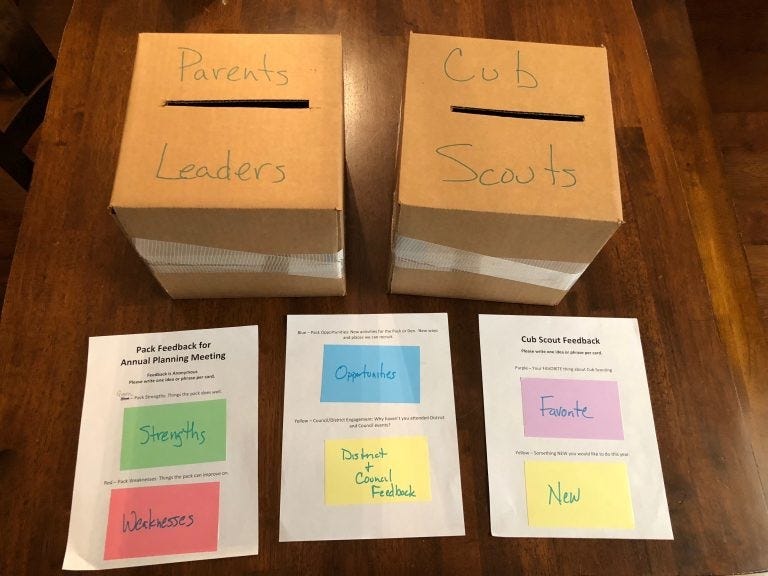This was originally a LinkedIn article that I wrote back in June 2018.
I’m the new Cubmaster for my son’s Cub Scout Pack. The pack has had a bit of a bumpy year, with a bit of leader churn, and Hurricane Harvey impacted both our annual fundraising and recruitment. To help construct a better next year, I decided to implement some Lean principles into our annual planning process.
PRE-WORK
The first thing I did was obtain the “Voice of the Customer” via some anonymous comment cards at a pack meeting. I used a modified SWOT analysis for parents, asking them to tell us what they thought were the pack’s Strengths, Weaknesses, Opportunities (for new activities and recruitment), and why we hadn’t had stronger participation at our District and Council events. I decided on replacing the “Threats” with this last option, as it was a specific element of feedback I was interested in.
All of the instructions were laid out with Standard Work:
The Strengths and Weakness cards were color-coded green and red
Opportunities and District/Council Feedback were color-coded in the Cub Scout colors of blue and gold.
We asked Scouts for their Favorite thing (purple) about Cub Scouts, and what New thing (yellow) they wanted to do.
While parents were very happy to share their feedback, you would have thought we told every Cub Scout they got an extra birthday that year. I can’t share enough how excited these elementary school kids were to have someone ask their opinion.
All feedback was requested as anonymous, and kept in sealed boxes until our planning meeting. I wouldn’t sift through any answers to remove any specific pieces of feedback, nor would I get any time to think ahead on what was shared.
EVENT PREP
For the planning meeting I prepared a Kaizen Wall with butcher paper for stickies. The areas included the individual requirements for each rank (our Voice of the Process), spaces for the pre-work feedback, and a calendar for the next twelve months.
We also had in attendance the district volunteer who assists our pack – our District Commissioner (the Voice of the Business).
We kept a visual agenda, using stickies. That way as we closed out items, we could move them down and everyone could continuously see a visual representation of how the meeting agenda was progressing, and what was being accomplished.
KAIZEN PLANNING EVENT
The first thing we did was go through the comment cards. I had a different leader read through each card, and tape them to the butcher paper. We did some affinity grouping to help correlate the feedback. To help keep the event active, and encouraging everyone to be an active participant, I asked everyone to stand by the wall and discuss items as they were being shared.
As you can see in the banner photo, our Scouts *REALLY* love camping (the big blob of purple cards). Once we had input on what our parents and Scouts wanted in the next year, we started building our calendar.
Our District Commissioner helped us add in all of the pre-existing dates for the district and council events. With the addition of school holidays, we could easily see what days we had left to work with.
We then used blue and pink stickies to set out event dates for the year. When we realized one date wouldn’t work, we could easily pick up and move the sticky. With everyone engaged, and a fully visual representation of our calendar, we were able to easily plan a year of activity for our Scouts – taking into account the feedback from both parents and Scouts.
THE END RESULT
We had numerous accomplishments – many of which I believe were a result of incorporating just a few Lean Principles into our planning process. The major ones that come to mind are:
Our 12-month plan was based on feedback from our “customers” (both parents and Scouts), not just ideas from the leadership team.
Scouts, parents and volunteer leaders all said they were glad to have their voices heard – resulting in a plan with more ownership and buy-in from everyone.
We planned activities that both incorporated both the “Favorite” and the “New” things from the Scouts.
We planned activities that will help us have greater involvement in District and Council events.
We planned activities that cost less – offsetting the impact of reduced fundraising from the prior year.
We planned Summer activities to help us retain existing Scouts, and recruit new Scouts – offsetting the impact of reduced recruitment from the prior year.
Now, I don’t begin to think that previous planning efforts or years of program were lacking, or in vain. We’ve thoroughly enjoyed our time in the pack to-date. And, this is a Cub Scouting program that has served its community for more than 50 years. Nor do I think that the introduction of these Lean tools made some magical difference.
But – I am confident that we were able to use the Lean tools – specifically the Voice of the Customer – to better plan a program that meets the needs of its customers (both the Scouts and their parents). I’m also confident that we have feedback (from parents in particular) to implement continuous improvement efforts within the pack throughout the year.
If you’d like, you can see more of our Cub Scout Kaizen event photos on our Facebook Page.





